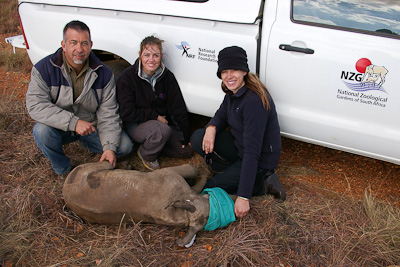 |
Pictured from the left are: Prof. Paul Grobler (UFS), Prof. Antoinette Kotze (NZG) and Ms. Karen Ehlers (UFS).
Photo: Supplied |
Scientists at the University of the Free State (UFS) are involved in a research study that will help to trace the source of any southern white rhino product to a specific geographic location.
This is an initiative of the National Zoological Gardens of South Africa (NZG).
Prof. Paul Grobler, who is heading the project in the Department of Genetics at the UFS, said that the research might even allow the identification of the individual animal from which a product was derived. This would allow law enforcement agencies not only to determine with certainty whether rhino horn, traded illegally on the international black market, had its origin in South Africa, but also from which region of South Africa the product came.
This additional knowledge is expected to have a major impact on the illicit trade in rhino horn and provide a potent legal club to get at rhino horn smugglers and traders.
The full research team consists of Prof. Grobler; Christiaan Labuschagne, a Ph.D. student at the UFS; Prof. Antoinette Kotze from the NZG, who is also an affiliated professor at the UFS; and Dr Desire Dalton, also from the NZG.
The team’s research involves the identification of small differences in the genetic code among white rhino populations in different regions of South Africa. The genetic code of every species is unique, and is composed of a sequence of the four nucleotide bases G, A, T and C that are inherited from one generation to the next. When one nucleotide base is changed or mutated in an individual, this mutated base is also inherited by the individual's progeny.
If, after many generations, this changed base is present in at least 1% of the individuals of a group, it is described as a single nucleotide polymorphism (SNP), pronounced "snip". Breeding populations that are geographically and reproductively isolated often contain different patterns of such SNPs, which act as a unique genetic signature for each population.
The team is assembling a detailed list of all SNPs found in white rhinos from different regions in South Africa. The work is done in collaboration with the Pretoria-based company, Inqaba Biotech, who is performing the nucleotide sequencing that is required for the identification of the SNPs.
Financial support for the project is provided by the Advanced Biomolecular Research cluster at the UFS.
The southern white rhino was once thought to be extinct, but in a conservation success story the species was boosted from an initial population of about 100 individuals located in KwaZulu-Natal at the end of the 19th century, to the present population of about 15 000 individuals. The southern white rhino is still, however, listed as “near threatened” by the World Wildlife Fund (WWF).
Media Release:
Mangaliso Radebe
Assistant Director: Media Liaison
Tel: 051 401 2828
Cell: 078 460 3320
E-mail: radebemt@ufs.ac.za
27 July 2010